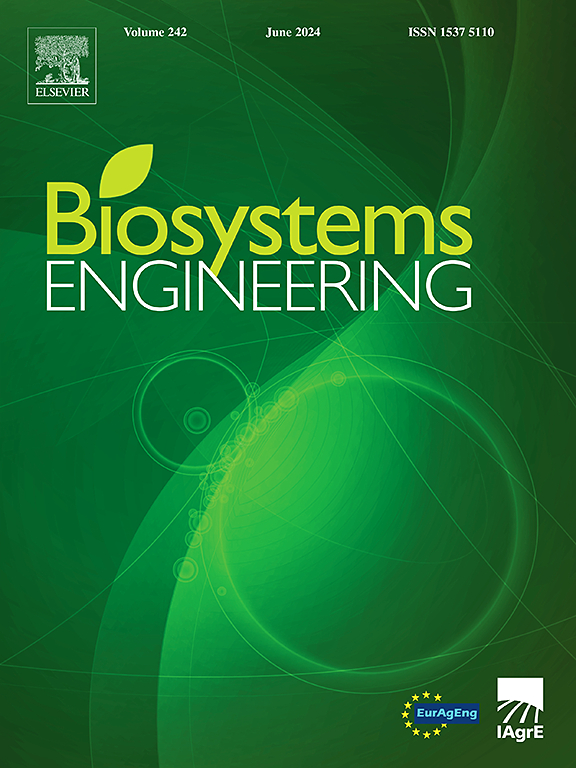Litchi bunch detection and ripeness assessment using deep learning and clustering with image processing techniques
IF 5.3
1区 农林科学
Q1 AGRICULTURAL ENGINEERING
引用次数: 0
Abstract
Litchis typically need to be harvested in bunches. The detection of entire litchi bunches and the classification of ripeness are crucial issues for robotic harvesting and are also prerequisites for efficient and non-destructive picking. However, the detection process is complicated by the complex orchard environment and the green colour of litchis, and research on the ripeness grading of litchi bunches is still lacking. To address this issue, this paper proposes a litchi ripeness assessment method combining three components: (1) Litchi-YOLO model, (2) a novel image processing framework, and (3) KGAP-DBSCAN clustering algorithm. The HyCTAS module is embedded into the YOLOv8 model to perform instance segmentation on the litchi fruits in the collected images, obtaining the fruit target points and masks. Then, the KGAP-DBSCAN clustering algorithm automatically clusters the fruit points into litchi bunches by setting the clustering radius ε based on the density of the target points. Ripeness grading of individual fruits is achieved by calculating the proportion of red pericarp and determining the ripeness of litchi bunches based on the agronomic information related to litchi growth. The results show that in terms of detection performance, Litchi-YOLO achieved a precision (P), recall (R), and F1-score of 95.96 %, 95.69 %, and 95.82 %, respectively, representing improvements of 1.25 %, 6.97 %, and 4.25 % over YOLOv8. In terms of clustering performance, the KGAP-DBSCAN algorithm achieved homogeneity, completeness, and v-measure scores of 0.91, 0.76, and 0.78, respectively, for clustering the fruit coordinate points. The ripeness grading method for individual fruits demonstrated good performance, with a precision of 94.20 % and a recall of 91.91 %. The ripeness of the litchi bunches, calculated from the ripeness parameters of individual fruits and clustering results, meets agronomic requirements. The study assesses the maturity of litchi bunches in a natural environment, assisting the orchard harvesting robot system in determining harvesting decisions.
基于深度学习和聚类图像处理技术的荔枝束检测和成熟度评估
荔枝通常需要成串收获。荔枝整串的检测和成熟度分类是机器人采摘的关键问题,也是高效、无损采摘的先决条件。然而,由于果园环境复杂,荔枝本身呈绿色,检测过程较为复杂,荔枝串的成熟度分级研究尚缺乏。针对这一问题,本文提出了一种荔枝成熟度评价方法,该方法由三个部分组成:(1)litchi - yolo模型,(2)一种新的图像处理框架,(3)KGAP-DBSCAN聚类算法。HyCTAS模块嵌入到YOLOv8模型中,对采集图像中的荔枝果实进行实例分割,得到果实目标点和蒙版。然后,KGAP-DBSCAN聚类算法根据目标点的密度设置聚类半径ε,自动将水果点聚为荔枝簇。通过计算红果皮的比例,并根据荔枝生长相关的农艺信息确定荔枝串的成熟度,从而实现单个果实的成熟度分级。结果表明,在检测性能方面,荔枝- yolo的检测精度(P)、召回率(R)和f1分数分别为95.96%、95.69%和95.82%,分别比YOLOv8提高了1.25%、6.97%和4.25%。在聚类性能方面,KGAP-DBSCAN算法对水果坐标点的聚类均匀性、完备性和v-measure得分分别为0.91、0.76和0.78。该方法对单个水果的成熟度进行分级,准确率为94.20%,召回率为91.91%。根据单果成熟参数和聚类结果计算出的荔枝串的成熟度符合农艺要求。该研究在自然环境中评估荔枝束的成熟度,帮助果园收获机器人系统确定收获决策。
本文章由计算机程序翻译,如有差异,请以英文原文为准。
求助全文
约1分钟内获得全文
求助全文
来源期刊

Biosystems Engineering
农林科学-农业工程
CiteScore
10.60
自引率
7.80%
发文量
239
审稿时长
53 days
期刊介绍:
Biosystems Engineering publishes research in engineering and the physical sciences that represent advances in understanding or modelling of the performance of biological systems for sustainable developments in land use and the environment, agriculture and amenity, bioproduction processes and the food chain. The subject matter of the journal reflects the wide range and interdisciplinary nature of research in engineering for biological systems.
 求助内容:
求助内容: 应助结果提醒方式:
应助结果提醒方式:


